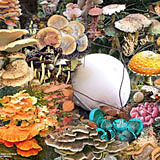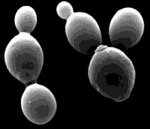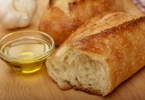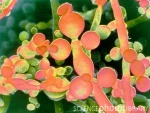Difference between revisions of "What are yeast?"
| Line 1: | Line 1: | ||
[[File:Fungi.jpeg|thumb|left|'''Introduction to Fungi''' Credit: ''Kandis Elliot, Mo Fayyaz, University of Wisconsin, Madison'']] | [[File:Fungi.jpeg|thumb|left|'''Introduction to Fungi''' Credit: ''Kandis Elliot, Mo Fayyaz, University of Wisconsin, Madison'']] | ||
| − | [http://en.wikipedia.org/wiki/Yeast Yeast] are single-celled eukaryotic microorganisms that are classified, along with molds and mushrooms as members of the kingdom [http://en.wikipedia.org/wiki/Fungus Fungi]. Yeasts are phylogenetically diverse, and consequently are classified in two separate phyla, the [http://en.wikipedia.org/wiki/Ascomycota ''Ascomycota''] and the [http://en.wikipedia.org/wiki/Basidiomycota Basidiomycota]. Budding yeast (also called “true yeasts”), such as [http://en.wikipedia.org/wiki/Saccharomyces_cerevisiae ''Saccharomyces cerevisiae''] are classified in the order [http://en.wikipedia.org/wiki/Saccharomycetales ''Saccharomycetales''], which is under Ascomycota. | + | [http://en.wikipedia.org/wiki/Yeast Yeast] are single-celled eukaryotic microorganisms that are classified, along with molds and mushrooms as members of the kingdom [http://en.wikipedia.org/wiki/Fungus Fungi]. Yeasts are phylogenetically diverse, and consequently are classified in two separate phyla, the [http://en.wikipedia.org/wiki/Ascomycota ''Ascomycota''] and the [http://en.wikipedia.org/wiki/Basidiomycota Basidiomycota]. Budding yeast (also called “true yeasts”), such as the well-known species, [http://en.wikipedia.org/wiki/Saccharomyces_cerevisiae ''Saccharomyces cerevisiae''] are classified in the order [http://en.wikipedia.org/wiki/Saccharomycetales ''Saccharomycetales''], which is under Ascomycota. [http://en.wikipedia.org/wiki/Biological_classification Biological classification] is based on characteristics of the cell, ascospore and colony. Physiological characteristics are also used to identify species. One of the most well known characteristics of yeast is the |
| + | ability to ferment sugars for the production of ethanol. | ||
Saccharomyces cerevisiae are one of the most well-known and commercially significant species of yeast. These organisms have long been utilized to ferment the sugars of rice, wheat, barley, and corn to produce alcoholic beverages, and to expand and raise dough to make bread. | Saccharomyces cerevisiae are one of the most well-known and commercially significant species of yeast. These organisms have long been utilized to ferment the sugars of rice, wheat, barley, and corn to produce alcoholic beverages, and to expand and raise dough to make bread. | ||
Revision as of 09:28, 11 April 2012
Yeast are single-celled eukaryotic microorganisms that are classified, along with molds and mushrooms as members of the kingdom Fungi. Yeasts are phylogenetically diverse, and consequently are classified in two separate phyla, the Ascomycota and the Basidiomycota. Budding yeast (also called “true yeasts”), such as the well-known species, Saccharomyces cerevisiae are classified in the order Saccharomycetales, which is under Ascomycota. Biological classification is based on characteristics of the cell, ascospore and colony. Physiological characteristics are also used to identify species. One of the most well known characteristics of yeast is the ability to ferment sugars for the production of ethanol.
Saccharomyces cerevisiae are one of the most well-known and commercially significant species of yeast. These organisms have long been utilized to ferment the sugars of rice, wheat, barley, and corn to produce alcoholic beverages, and to expand and raise dough to make bread. Most yeast reproduce asexually by an asymmetric division process called budding rather than by binary fission. A small bud emerges from the surface of the parent cell and enlarges until it is almost the size of the parent.
Yeast are unicellular fungi. The precise
classification is a field that uses the characteristics of the cell,
ascospore and colony. Physiological characteristics are also used to
identify species. One of the more well known characteristics is the
ability to ferment sugars for the production of ethanol. Budding
yeast are true fungi of the phylum Ascomycota,
class Saccharomycetes (also called Hemiascomycetes).
The true yeast is separated into one main order Saccharomycetales.
Yeast are characterized by a wide dispersion of natural habitats.
Common on plant leaves and flowers, soil and salt water. Yeast are
also found on the skin surfaces and in the intestinal tracts of
warm-blooded animals, where they may live symbiotically or as
parasites. The common "yeast infection" Candidiasis
is typically caused by the yeast-like fungus Candida albicans. In addition to being the causative agent in vaginal yeast infections Candida is also a cause of diaper rash and
thrush of the mouth and throat.
Yeast multiply as single cells that divide by budding (eg. Saccharomyces) or direct division (fission,
eg. Schizosaccharomyces), or they may grow as simple irregular
filaments (mycelium). In sexual reproduction most yeast form asci,
which contain up to eight haploid ascospores. These ascospores may
fuse with adjoining nuclei and multiply through vegetative division
or, as with certain yeast, fuse with other ascospores.
The awsome power of yeast genetics is partially due to the ability to
quickly map a phenotype producing gene to a region of the S.
cerevisiae genome. For the past two decades S. cerevisiae
has been the model system for much of molecular genetic research
because the basic cellular mechanics of replication, recombination,
cell division and metabolism are generally conserved between yeast and
larger eukaryotes, including mammals.
The most well-known and commercially significant yeast are the
related species and strains of Saccharomyces cerevisiae. These
organisms have long been utilized to ferment the sugars of rice,
wheat, barley, and corn to produce alcoholic beverages and in the
baking industry to expand, or raise, dough. Saccharomyces
cerevisiae is commonly used as baker's yeast and for some types of
fermentation. Yeast is often taken as a vitamin supplement because it
is 50 percent protein and is a rich source of B vitamins such as
niacin, folic acid, riboflavin, and biotin.
In brewing, Saccharomyces carlsbergensis, named after the Carlsberg Brewery in Copenhagen, where it was first isolated in pure culture by Dr. Emil Christian Hansen (1842-1909) in 1883, is used in the production of several types of beers including lagers. S. carlsbergensis is used for bottom fermentation. S. cerevisiae used for the production of ales and conducts top fermentation, in which the yeast rise to the surface of the brewing vessel. In modern brewing many of the original top fermentation strains have been modified to be bottom fermenters. Currently the S. carlsbergensis designation is not used, the S. cerevisiae classification is used instead.
The yeast's function in baking is to ferment sugars present in the
flour or added to the dough. This fermentation gives off carbon
dioxide and ethanol. The carbon dioxide is trapped within tiny
bubbles and results in the dough expanding, or rising. Sourdough
bread, is not produced with baker's yeast, rather a combination of
wild yeast (often Candida milleri) and an acid-generating
bacteria (Lactobacillus sanfranciscensis sp. nov). It has been
reported that the ratio of wild yeast to bacteria in San Francisco
sourdough cultures is about 1:100. The C. milleri strengthens
the gluten and the L. sanfrancisco ferments the maltose. For
more information about sourdough see rec.food.sourdough FAQ.
The fermentation of wine is initiated by naturally occurring yeast
present in the vineyards. Many wineries still use natural strains,
however many use modern methods of strain maintenance and isolation.
The bubbles in sparkling wines is trapped carbon dioxide, the result
of yeast fermenting sugars in the grape juice. One yeast cell can
ferment approximately its own weight of glucose per hour. Under
optimal conditions S. cerevisiae can produce up to 18 percent,
by volume, ethanol with 15 to 16 percent being the norm. The sulfur
dioxide present in commercially produced wine is actually added just
after the grapes are crushed to kill the naturally present bacteria,
mold, and yeast.
The yeast-like fungus, Candida albicans, is commonly found in the mouth, vagina, and intestinal tract. Candida is a normal inhabitant of humans and normally causes no ill effects. However, among infants and individuals with other illness a variety of conditions can occur. Candidiasis of the mucous membranes of the mouth is known as thrush. Candidiasis of the vagina is called vaginitis. Candida also causes severe disease in persons with AIDS and chemotherapy patients.
Suggested Reading:
Campbell, I., and Duffus, J.H., eds., Yeast (1988)
Pfaff, Herman Jan, et al., The Life of Yeasts (1978)
The Early Days of Yeast Genetics. (1993) edited by Michael N. Hall and Patrick Linder. Cold Spring Harbor Laboratory Press, Cold Spring Harbor, New York.
Mortimer, R.K., Contopoulou, C.R. and J.S. King (1992) Genetic and physical maps of Saccharomyces cerevisiae, Edition 11. Yeast 8:817-902.
The Molecular and Cellular Biology of the Yeast Saccharomyces cerevisiae: Gene Expression. (1992) edited by Elizabeth W. Jones, John R. Pringle, and James R. Broach. Cold Spring Harbor Laboratory Press, Cold Spring Harbor, New York.
The Molecular and Cellular Biology of the Yeast Saccharomyces cerevisiae: Genome Dynamics, Protein Synthesis, and Energetics. (1991) edited by James R. Broach, John R. Pringle, and Elizabeth W. Jones. Cold Spring Harbor Laboratory Press, Cold Spring Harbor, New York.



